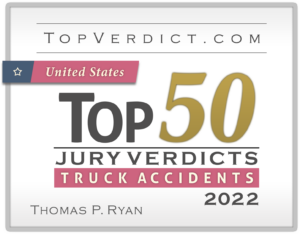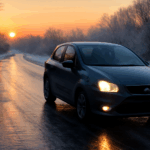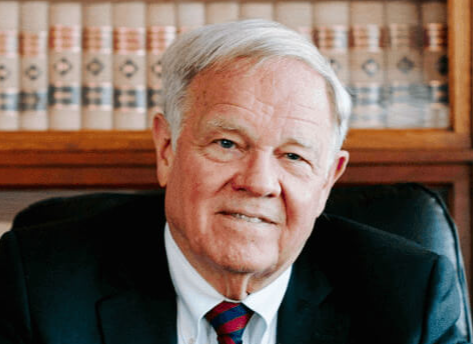


1. The Reality of Early Morning Frost and Black Ice 
Winter weather brings unique challenges, especially during the early morning hours. As temperatures drop overnight, frost can accumulate quickly on roadways. What’s even more dangerous is black ice—an invisible layer of ice that often forms during the night and early morning when the temperatures hover around freezing. Black ice is particularly hazardous because it’s nearly invisible, making it difficult for drivers to detect until it’s too late.
- What Makes Black Ice Dangerous: Black ice forms when moisture on the road freezes, usually during the night. Because of its transparency, it blends in with the color of the asphalt, making it incredibly difficult for drivers to see. It often appears on bridges, overpasses, and shaded areas of roads, all of which tend to freeze faster than other sections of the roadway.
- Common Early Morning Crashes: Early morning hours between 5:00 AM and 8:00 AM are prime times for black ice-related crashes. Drivers are often rushing to get to work or other appointments, and the combination of dark roads, low visibility, and cold temperatures can lead to dangerous outcomes.
Dan Ryan
Attorney

Elizabeth Fitzgerald
Paralegal
Our objectives remain clear in every case we pursue: To give every client, without delay, excuse or equivocation, our full attention, sound advice and forceful representation.
About Our Firm2. Understanding the “Sudden Emergency” Defense
The “sudden emergency” defense is often raised in car accident cases where a driver tries to excuse their actions by claiming they were faced with an unexpected situation that left them with no time to react properly. In the case of a black ice-related crash, this defense might be used to argue that the driver couldn’t control the vehicle due to the slippery roads.- What is the “Sudden Emergency” Defense? The defense essentially argues that the defendant had no reasonable time to react and avoid the accident because they were suddenly confronted with an emergency situation that was beyond their control. In black ice cases, this could mean the driver claims they lost control of the vehicle due to the icy road conditions.
- When Does This Defense Fail? While the “sudden emergency” defense may be applicable in some situations, it often fails when it’s clear that the driver’s actions contributed to the crash. For instance, if a driver was speeding or failed to account for the icy conditions, they can still be held liable despite the road being slippery. The courts may evaluate whether the driver acted reasonably in response to the situation. Simply being surprised by the weather isn’t enough to completely absolve the driver of fault.
3. Challenging the “Sudden Emergency” Defense in Car Accident Cases
When dealing with accidents caused by black ice, the key to challenging the “sudden emergency” defense lies in demonstrating that the driver was negligent or reckless before, during, or after encountering the emergency. Here’s how you can challenge this defense effectively:- Prove Negligence or Recklessness: The defense hinges on the assumption that the driver acted reasonably under the circumstances. However, if the driver was speeding, driving too closely behind another vehicle, or failing to adjust their driving speed for icy roads, this undermines the defense. Showing that the driver was negligent in their approach to the weather conditions can help defeat the sudden emergency argument.
- Speeding and Weather Conditions: The speed limit is set for ideal road conditions, not during hazardous winter conditions. Even if the speed limit was 50 mph, driving at that speed on a road covered with black ice is reckless. A reasonable driver would have slowed down significantly under these conditions. Proving that the driver failed to adjust their speed to the conditions is a key point in disputing the sudden emergency defense.
- Weather Alerts and Warnings: Weather reports and local warnings can also play a role in challenging the defense. If the area had been under a winter weather advisory, and the driver failed to take necessary precautions, it can be argued that the driver was aware or should have been aware of the potential for black ice and therefore should have driven more cautiously.
- Testimony from Expert Witnesses: Expert testimony can be crucial in proving that the driver was negligent. For example, accident reconstruction experts can analyze the crash scene and the evidence, such as tire tracks or vehicle damage, to show that the crash could have been prevented with safer driving practices. A meteorologist can testify about weather conditions at the time of the accident, confirming that the road was likely covered with black ice.

The attorneys at Ryan Injury Lawyers treat you like family. They are extremely professional, kind, respectful and intelligently know the law. Highly recommend. They are well above par.
- Zora S.
![]()

Great service and very professional. They actually make themselves available when you call. I will be referring Ryan to all of my friends and colleagues.
- Lashawn H.
![]()
4. The Importance of Evidence in Defending Against the “Sudden Emergency” Defense
To successfully challenge the “sudden emergency” defense, gathering compelling evidence is crucial. Here’s what you should focus on:- Document the Accident Scene: At the accident scene, take photos of the road conditions, including any frost or black ice on the road. This can help demonstrate the severity of the hazard. Also, photograph the damage to the vehicle, any tire marks that show the driver’s reaction to the situation, and the surrounding area to give context to the crash.
- Witness Testimony: If there were any witnesses to the crash, their testimony can be critical. They can confirm whether the defendant appeared to be driving recklessly or if they were behaving cautiously. Witnesses can also describe the weather conditions at the time of the accident.
- Traffic Cameras or Dashcam Footage: In many cases, dashcam footage can be a game changer. If you have access to video from the accident, it can show how the driver behaved before, during, and after the crash. This can be particularly useful in showing that the driver failed to adjust to the icy conditions.
- Accident Reports and Police Records: Police reports often contain vital information, such as the road conditions, the driver’s behavior, and whether the officer believes the driver was at fault. A thorough police investigation can help provide an impartial view of the circumstances surrounding the accident.
5. What to Do After a Black Ice Accident
After an accident caused by black ice, there are specific steps you should take to ensure that your rights are protected and you are properly compensated:- Seek Medical Attention Immediately: Even if you feel fine immediately after the crash, it’s essential to seek medical attention. Many injuries from car accidents, particularly whiplash or concussions, may not be immediately apparent.
- Collect Evidence at the Scene: As mentioned, gather as much evidence as possible from the scene. This includes taking photos of the vehicle, the road conditions, and any visible signs of black ice.
- Contact an Experienced Personal Injury Lawyer: Dealing with insurance companies and legal defenses like the “sudden emergency” defense can be complex. A lawyer from Ryan Injury Attorneys can help guide you through the process, ensuring that you have the support you need to challenge the defense and get the compensation you deserve.


